Introduction
Imagine biting into a cupcake so fluffy and moist, you’d never guess it’s gluten-free—and it’s ready in 30 minutes! Whether you’re racing against the clock for a last-minute party treat or craving a sweet escape after a long day, these [Gluten Free Cupcakes] are here to save the day. No complicated steps, no mysterious ingredients, just pure, buttery bliss that even gluten-lovers will devour.
Did you know gluten-free baking once meant dense, crumbly disasters? Thankfully, times have changed! This recipe uses smart swaps (like almond flour and xanthan gum) to mimic that classic cupcake texture we all adore. It’s so simple, my 10-year-old niece calls them “magic muffins” because they vanish faster than she can lick the bowl.
Compared to our popular [Gluten Free Chocolate Brownies], these cupcakes are lighter, faster, and perfect for birthdays, bake sales, or sneaking into movie night. Ready to bake your way to happiness? Let’s go!
Essential Ingredients for Perfect Gluten Free Cupcakes
Creating perfect Gluten Free Cupcakes starts with choosing the right ingredients. Each component plays a crucial role in ensuring your cupcakes are delicious, tender, and structurally sound. Below, you’ll find a detailed table that summarizes the essential ingredients along with smart substitutions for an optimized gluten-free recipe.
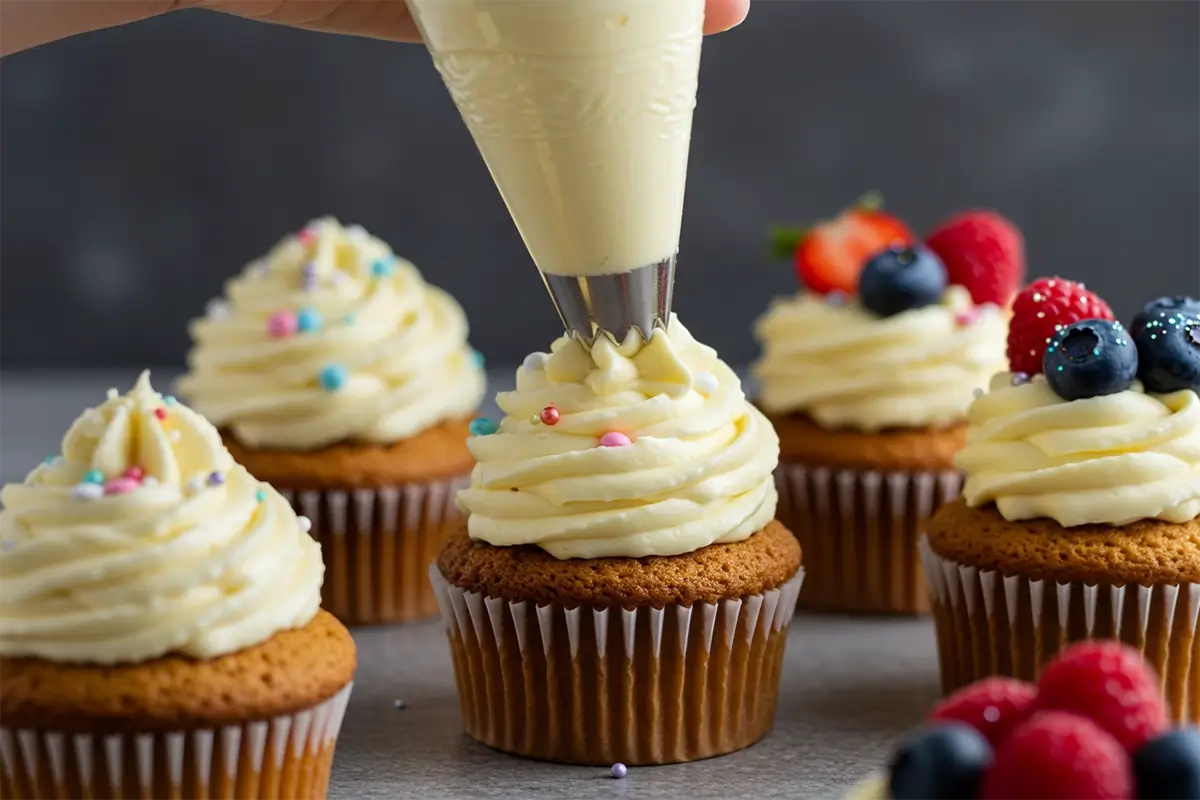
Key Ingredient Comparison Table
| Ingredient Category | Traditional Ingredient | Gluten-Free Substitute / Alternative | Notes |
|---|---|---|---|
| Flour | Wheat Flour | Gluten-free flour blend (rice, almond, coconut) | Sift for a smoother batter and even distribution |
| Binding Agents | Eggs | Flaxseed or chia slurry (1 tbsp with 3 tbsp water per egg) | Enhances structure in Gluten Free Cupcakes |
| Dairy | Milk, Butter | Almond milk, coconut milk, or dairy-free butter | Opt for unsweetened varieties for subtle flavor enhancement |
| Sweeteners | Granulated Sugar | Honey, maple syrup | Natural sweeteners can elevate the flavor profile |
| Leavening Agents | Baking Powder, Baking Soda | Certified gluten-free versions | Ensures proper rising and a light, airy texture |
Using this table as a reference, you can quickly identify which traditional ingredients need a gluten-free alternative, ensuring that every batch of your Gluten Free Cupcakes meets dietary requirements without compromising on taste or texture. This structured approach not only improves the clarity of your recipe but also enhances its search engine visibility by reinforcing the key elements needed for successful gluten-free baking.
Step-by-Step Guide to 30-Minute Gluten Free Cupcakes
Craving fluffy, delicious 30-minute gluten free cupcakes recipe? Let’s bake your new favorite treat in half the time—no stress, no mess!
Step 1: Preheat and Prepare
- Preheat the Oven: Set your oven to 350°F (175°C) to ensure even baking for your Gluten Free Cupcakes.
- Prepare Your Pan: Line a cupcake tin with paper liners or grease it lightly. This helps maintain the shape and texture of your cupcakes while preventing sticking.
Step 2: Mix the Dry Ingredients

- Combine Your Flour and Leavening Agents: In a large bowl, sift together your gluten-free flour blend, baking powder, and a pinch of salt. Sifting not only helps to avoid clumps but also ensures that your Gluten Free Cupcakes have a light, airy texture.
- Optional Extras: For an enhanced flavor, you can add a small amount of cornstarch or xanthan gum, depending on your gluten-free flour’s composition.
Step 3: Whisk the Wet Ingredients
- Beat the Eggs: In a separate bowl, whisk the eggs until they are light and frothy. Eggs are crucial for binding the ingredients and giving structure to your cupcakes.
- Add Liquids and Flavorings: Stir in your milk (or a dairy-free alternative like almond or oat milk), vanilla extract, and oil or melted dairy-free butter. These ingredients contribute to the moistness and rich flavor of your Gluten Free Cupcakes.
Step 4: Combine Dry and Wet Mixtures
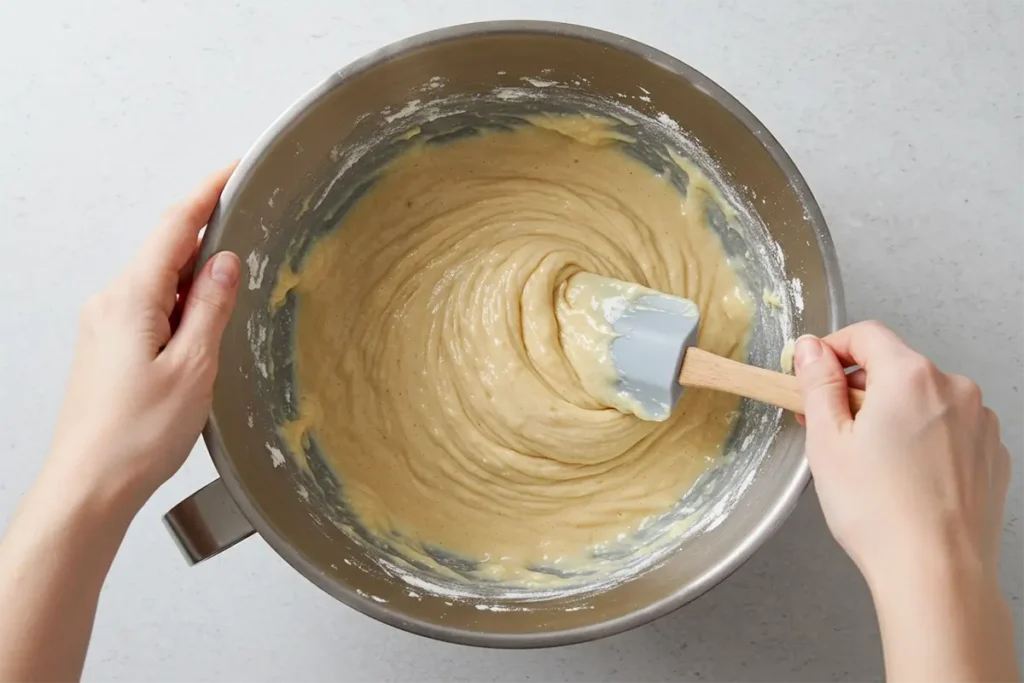
- Gently Fold Together: Pour the wet ingredients into the dry mixture. Stir gently until just combined; overmixing can lead to dense cupcakes. The goal is a smooth batter that still retains some air for fluffiness.
- Maintain Texture: This careful mixing process is key to achieving the soft crumb and consistent structure expected in high-quality Gluten Free Cupcakes.
Step 5: Fill the Cupcake Liners
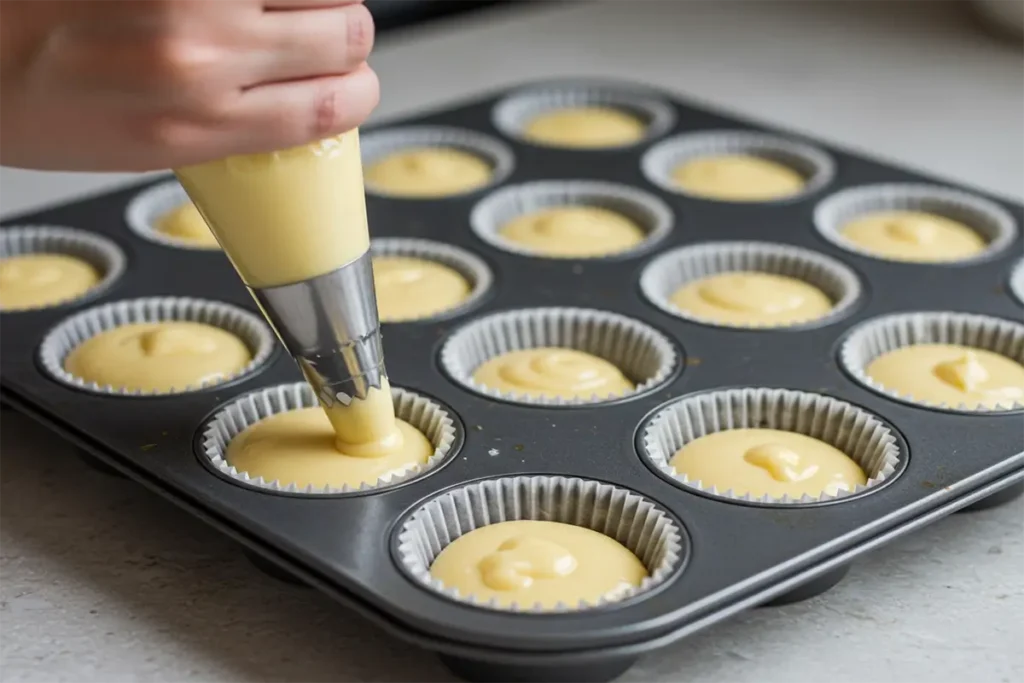
- Portion the Batter: Using a spoon or a piping bag, evenly distribute the batter into your cupcake liners. Fill each liner about 2/3 full to allow room for the cupcakes to rise.
- Even Distribution: Consistent batter levels ensure that all your cupcakes bake evenly, maintaining the professional look and texture of your Gluten Free Cupcakes.
Step 6: Bake to Perfection

- Bake: Place the cupcake tin in your preheated oven. Bake for 25-30 minutes, or until a toothpick inserted into the center of a cupcake comes out clean.
- Monitor Your Oven: Because every oven can behave differently, start checking a couple of minutes before the minimum baking time to prevent overbaking, which can affect the moisture in your Gluten Free Cupcakes.
Step 7: Cool and Frost
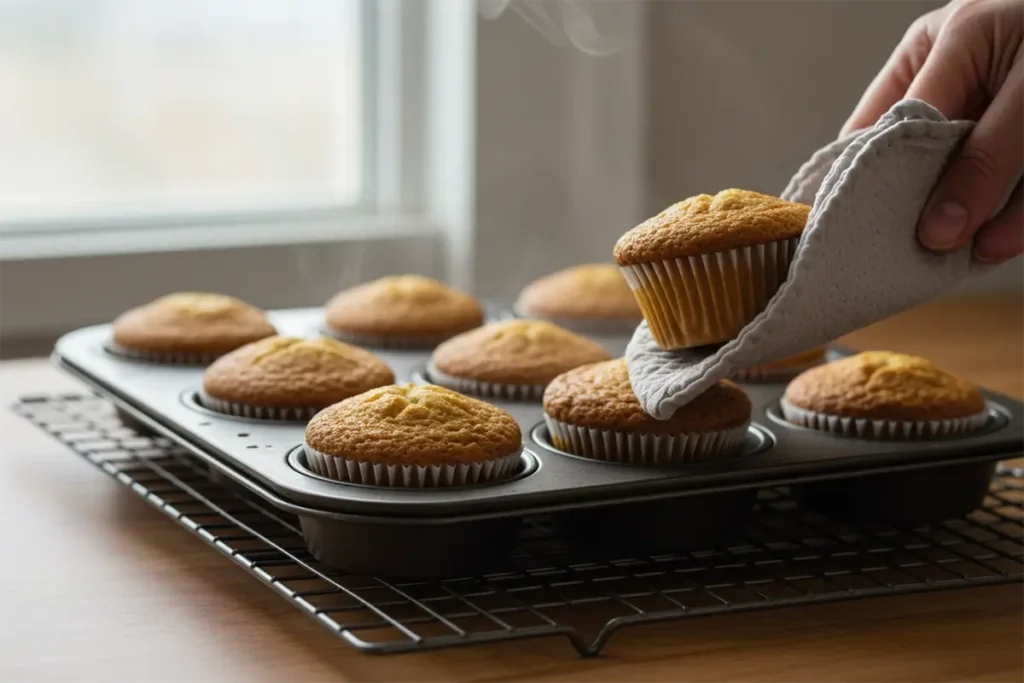
- Cooling Time: Allow the cupcakes to cool in the tin for 5 minutes before transferring them to a wire rack. Cooling helps set the structure and prevents the cupcakes from becoming soggy.
- Apply Your Favorite Frosting: Once completely cooled, frost your cupcakes with a delicious buttercream, cream cheese frosting, or a dairy-free alternative. This final touch not only enhances flavor but also adds visual appeal to your Gluten Free Cupcakes.
Step 8: Serve and Enjoy
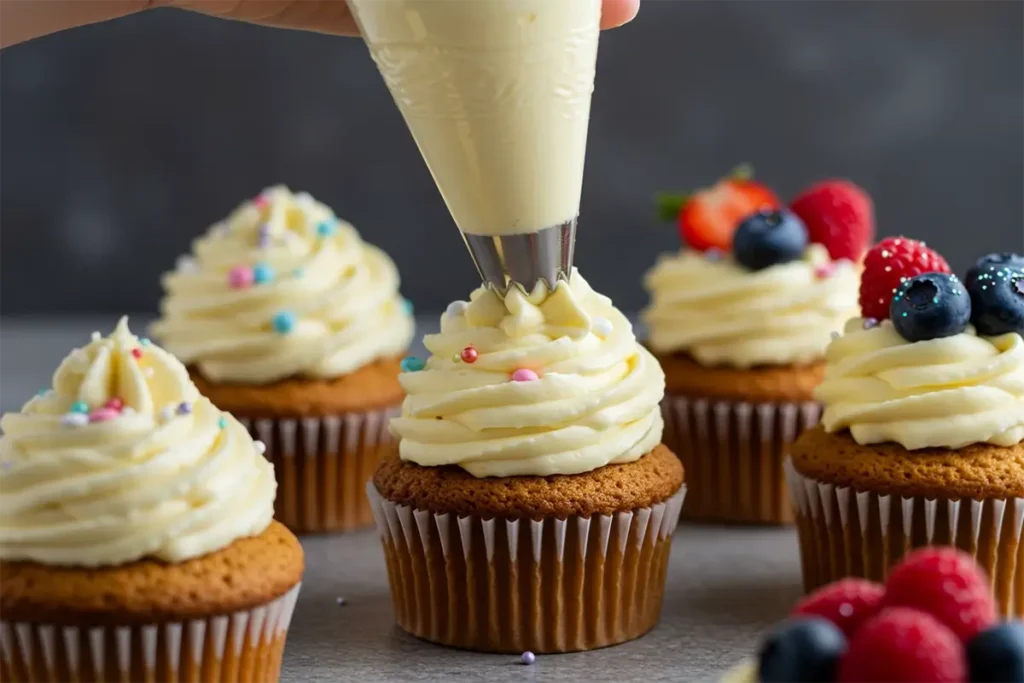
Enjoy: Serve your cupcakes at room temperature, and enjoy the perfect blend of taste, texture, and the confidence that comes from following a reliable recipe for Gluten Free Cupcakes.
Presentation: Decorate your cupcakes as desired—sprinkles, fresh fruit, or a dusting of powdered sugar can add a festive touch.
Necessary Equipment and Preparation Tips
Creating flawless Gluten Free Cupcakes starts long before you preheat your oven—it begins with having the right tools and setting up a proper workspace. Whether you’re a seasoned baker or just transitioning to gluten-free recipes, investing in quality equipment and following proven preparation tips is key to consistent, bakery-quality results.
Essential Equipment for Gluten Free Cupcakes
Having reliable, dedicated kitchen tools can make all the difference when working with gluten-free ingredients, which can be more sensitive to mixing and moisture levels. Below is a table outlining must-have equipment along with their purposes and helpful tips for achieving perfect Gluten Free Cupcakes.
| Equipment | Purpose & Benefits | Tips & Recommendations |
|---|---|---|
| Stand or Hand Mixer | Efficiently beats batter and incorporates air, ensuring a light and fluffy texture in your cupcakes. | Use the paddle attachment for even mixing; avoid overmixing to prevent a dense crumb. |
| Mixing Bowls (Various Sizes) | For combining dry and wet ingredients separately before mixing them together. | Use glass or stainless steel bowls for easy cleaning and better ingredient control. |
| Digital Kitchen Scale | Ensures accurate measurements, especially important with gluten-free flours where volume can vary. | Weigh all ingredients to improve consistency and replicate your perfect Gluten Free Cupcakes. |
| Cupcake/Muffin Tin | Provides even heat distribution; using quality pans can prevent over-browning and sticking. | Line with nonstick or silicone cupcake liners to achieve a neat finish. |
| Piping Bags & Nozzles | Essential for decorating and applying frosting precisely to finished cupcakes. | Invest in reusable, quality piping bags for a professional look; practice piping techniques. |
| Cooling Rack | Allows cupcakes to cool evenly, which is critical to set the structure before frosting. | Transfer cupcakes promptly after cooling in the pan to avoid sogginess. |
| Oven Thermometer | Monitors accurate baking temperature, critical for gluten-free recipes that may be sensitive to heat. | Verify your oven’s calibration; a consistent temperature is key to a uniform rise in cupcakes. |
Preparation Tips for Perfect Gluten Free Cupcakes
Beyond the equipment, thoughtful preparation can greatly influence your end result. Follow these guidelines to set the stage for baking excellent Gluten Free Cupcakes:
- Pre-Measure Ingredients:
Use a digital kitchen scale to weigh all ingredients. Gluten-free flours and leavening agents can behave unpredictably if measured by volume. - Room-Temperature Ingredients:
Allow eggs, milk (or dairy-free alternatives), and butter to reach room temperature. This ensures better emulsification and a smoother batter. - Preheat the Oven Properly:
Set your oven to the recommended temperature and use an oven thermometer for accuracy. Even heat is crucial for gluten-free recipes, which are often more sensitive to temperature fluctuations. - Prepare Your Workspace:
Ensure your mixing bowls, utensils, and baking pans are clean and free from any gluten residue. This helps avoid cross-contamination and preserves the integrity of your Gluten Free Cupcakes. - Follow Mixing Instructions Carefully:
Gluten-free batters can be delicate. Mix just enough to combine ingredients; overmixing may lead to a denser texture or cause your cupcakes to fall after baking. - Line Your Pans:
Use high-quality nonstick cupcake liners or parchment paper. This not only prevents sticking but also promotes even baking and easy removal.
By assembling the right equipment and following these careful preparation tips, you’ll be well on your way to baking stunning, consistently delicious Gluten Free Cupcakes that stand out for their texture, flavor, and professional finish.
Decorating and Serving Suggestions
Elevate your Gluten Free Cupcakes with creative decorating and serving ideas that not only enhance their visual appeal but also boost their flavor and overall presentation. Whether you’re preparing these cupcakes for a special occasion or simply to treat yourself, consider the following tips to make your gluten-free delights stand out.
Frosting and Icing Options
- Buttercream Variations:
Experiment with classic vanilla buttercream, rich chocolate buttercream, or a tangy cream cheese frosting. For a dairy-free option, try using vegan butter or coconut cream blended with powdered sugar. Whip the frosting until light and fluffy, then use a piping bag with various tips to create elegant rosettes, borders, or swirls on your Gluten Free Cupcakes. - Glaze and Drizzle:
For a sleek finish, drizzle a simple glaze made from powdered sugar and a touch of milk (or a dairy-free alternative) over the cupcakes. You can also experiment with flavored glazes—lemon, raspberry, or even espresso—to complement your cupcake’s taste.
Creative Toppings and Decorations
- Edible Accents:
Enhance your Gluten Free Cupcakes with edible decorations like sprinkles, edible glitter, chopped nuts, or even fresh fruit slices. Seasonal toppings—such as cranberries in winter or berries in summer—add a burst of color and flavor. - Themed Decorations:
Consider tailoring your decorations to fit the occasion. For example, add pastel-colored sprinkles and delicate sugar flowers for a baby shower, or use bold, vibrant colors and themed toppers for a birthday celebration. - Texture Play:
Mix textures by topping cupcakes with a light dusting of powdered sugar or cocoa powder. A small dollop of fruit preserves or a thin layer of lemon curd in the center of your cupcakes can create an unexpected flavor twist.
Presentation and Serving Ideas
- Cupcake Stands and Trays:
Serve your Gluten Free Cupcakes on decorative cupcake stands or tiered trays to create a visually appealing spread. This arrangement not only highlights each cupcake but also makes them easier to serve at gatherings. - Pairing with Beverages:
Complement your cupcakes with carefully selected beverages. A cup of artisan coffee, a robust tea, or a sparkling beverage can enhance the flavors of your cupcakes and provide a complete dessert experience. - Personal Touches:
For a more personalized presentation, label each cupcake with edible markers or small flags that denote unique flavors or seasonal themes. This approach works especially well at parties and events, sparking conversation and delight among guests.
Storage and Transport
Temperature Considerations:
If you need to keep the cupcakes chilled, especially when using butter-based frostings, opt for insulated containers and serve them shortly after removing from refrigeration to maintain their ideal texture.
Keep It Fresh:
After decorating, store your Gluten Free Cupcakes in an airtight container to preserve their freshness and prevent the frosting from drying out. If you’re transporting them, consider using a sturdy cupcake carrier that keeps each cupcake secure and prevents smudging.
Expert Tips for Gluten Free Cupcake Success
Baking perfect Gluten Free Cupcakes requires a combination of precision, quality ingredients, and thoughtful techniques. Whether you’re a seasoned gluten-free baker or just starting out, these expert tips will help you consistently achieve light, fluffy, and delicious results.
1. Use Accurate Measurements and Quality Ingredients
- Weigh Your Ingredients:
Gluten-free flours often vary in density, so using a digital kitchen scale ensures accuracy. This precision is key for replicating successful recipes time after time. - Select a Reliable Flour Blend:
Opt for high-quality gluten-free flour blends that include xanthan gum or guar gum. These additives mimic gluten’s binding properties, providing the structure needed for a light, airy crumb. - Room-Temperature Ingredients:
Allow eggs, milk (or dairy-free alternatives), and butter to reach room temperature before mixing. This promotes better emulsification and a smoother, more uniform batter.
2. Master the Mixing Process
- Avoid Overmixing:
Gluten-free batters can quickly become dense if overmixed. Combine wet and dry ingredients just until incorporated to preserve the delicate air bubbles that contribute to a light texture. - Incorporate Air Strategically:
For added lift, gently fold in whipped egg whites at the end of your mixing process. This step helps create a sponge-like structure, essential for achieving fluffy Gluten Free Cupcakes. - Two-Step Mixing Technique:
First, beat your wet ingredients (including creamed butter and sugar) until light and frothy. Then, gradually add your dry ingredients to maintain consistency and prevent clumping.
3. Optimize Your Baking Conditions
- Preheat Your Oven Precisely:
Use an oven thermometer to verify the correct temperature. Gluten-free recipes are often sensitive to temperature fluctuations, so consistent heat is crucial. - Choose the Right Bakeware:
High-quality cupcake tins and liners ensure even heat distribution. Consider using silicone liners or parchment paper to prevent sticking and promote uniform rising. - Monitor Baking Time:
Gluten-free cupcakes can sometimes bake faster than traditional recipes. Begin checking for doneness a few minutes early to avoid overbaking, which can lead to dryness.
4. Cool and Decorate Thoughtfully
- Proper Cooling:
Let cupcakes cool in the pan for a few minutes before transferring them to a cooling rack. This helps set the structure and prevents breakage when moving delicate cupcakes. - Decorating with Care:
Enhance your Gluten Free Cupcakes with creative frosting techniques—whether it’s piping a classic buttercream, drizzling a flavored glaze, or topping with fresh fruit. Remember, too much moisture from decorative elements can sometimes affect the cupcake’s texture, so balance is key.
5. Troubleshoot Common Gluten-Free Baking Challenges
- Density Issues:
If your cupcakes are too dense, consider increasing the proportion of liquid ingredients or adding an extra egg white to boost aeration. - Sinking Cupcakes:
Sinking after baking often points to overmixing or incorrect oven temperatures. Ensure your oven is calibrated correctly and mix just until ingredients are combined. - Dry Texture:
For a moister result, incorporate additional fat (like dairy-free butter) or a small amount of fruit puree into your batter. Adjust these components gradually to achieve the desired texture without compromising structure.
6. Final Expert Advice
Balance is Everything:
Focus on creating a harmonious balance between flavor, texture, and appearance. The perfect cupcake not only tastes amazing but also looks enticing on the blog and in person.
Experiment in Small Batches:
Test new techniques or ingredient swaps on a small batch before scaling up. This approach minimizes waste and helps fine-tune your process.
Keep Detailed Notes:
Record measurements, brands, mixing times, and oven settings. Over time, these notes will help you consistently replicate your best Gluten Free Cupcakes.
Conclusion
In conclusion, mastering the art of Gluten Free Cupcakes is both a creative journey and a rewarding endeavor. By investing in quality ingredients, employing precise measurements, and following proven mixing and baking techniques, you can consistently produce cupcakes that are light, moist, and bursting with flavor. The tips, tricks, and expert advice shared throughout this post are designed to empower you to experiment confidently and elevate your gluten-free baking game.
Remember, every batch of Gluten Free Cupcakes is an opportunity to refine your process, discover new flavor combinations, and impress your audience with visually stunning and delicious treats. Whether you’re decorating for a special occasion or simply enjoying a homemade dessert, your commitment to quality and attention to detail will shine through in every bite.
We encourage you to try these strategies, share your experiences, and engage with our community. Your feedback not only helps improve your own baking adventures but also inspires fellow bakers to explore the delightful world of gluten-free creations. Enjoy the process, celebrate your successes, and let your passion for gluten-free baking transform ordinary moments into extraordinary treats.
